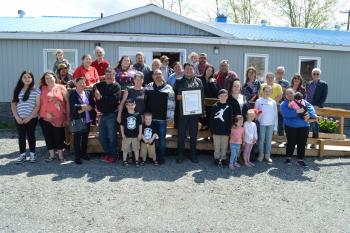Image Caption
Summary
Local Journalism Initiative Reporter
Windspeaker.com
On May 21, Beaverhouse First Nation leadership announced to members that the community had achieved historic formal recognition from the government of Canada that it is, indeed, a First Nation under section 35 of Canada’s Constitution.
A letter from Marc Miller, minister of Crown-Indigenous Relations, dated April 19 states that ‘Beaverhouse First Nation has demonstrated it is a section 35 rights-bearing First Nation collectivity.’
“It’s been a whirlwind of emotions for all of us in the community,” said Chief Wayne Wabie.
“I have been involved in this fight for most of my life alongside many of our past leaders, such as the late Chief Roy Meaniss, who was a long-time advocate for the community. It’s been an honour to carry on his legacy and to work with our community to achieve this goal.”
The community event began with a prayer and ceremony led by Chief Wabie, and included a message of support from his father and community Elder Tom Wabie.
The legal process for recognition was started by Chief Meaniss in the 1980s. Successive Beaverhouse First Nation chiefs—Chief Gloria McKenzie and Chief Sally Susan Mathias Martel—continued the process, with support and expertise from the Nishnawbe-Aski Nation (NAN), the regional political organization that represents First Nations in the Treaty #9 area. Beaverhouse First Nation as a member of Wabun Tribal Council also had that council’s support.
“This is a very emotional and proud moment for the people of Beaverhouse First Nation. To have this recognition from the government, from your partners within NAN, from townships and from neighbouring communities means that it is a powerful foundation to build upon,” said NAN Grand Chief Derek Fox, who attended the event. “We will be there to support Beaverhouse First Nation and help their nation continue to grow. I am extremely happy to be here with the community today.”
Lead legal representative, Kim Fullerton, was instrumental in pursuing section 35 recognition over the years. He is a long-time advocate for First Nation communities and organizations primarily in land claims against Canada and Ontario.
“This is a very significant event because Canada is recognizing a new First Nation in the country, which does not happen very often. This is a very proud day for all of us... It’s been a long time coming and it is very satisfying to be able to assist this wonderful group of people,” said Fullerton.
His wife Christine Dernoi was one of the key researchers that worked with Beaverhouse and NAN to prepare the legal case. Luke Hunter, director of Governance, Treaty Implementation for NAN, was also instrumental in advocating for and assisting Beaverhouse leadership in this process over many years.
First Nation recognition for Beaverhouse First Nation is the first step in starting the process of creating a new relationship with government. The community leadership and its members will now take the time to plan for the future direction of the Nation and negotiate with federal and provincial governments. A federal negotiator has been appointed and will soon start discussions on the process with a meeting planned for June.
The lack of official First Nation recognition by the government meant a lot of difficulty for the leadership in establishing, developing and maintaining social, health, education and administrative activities for its membership.
Chief Wabie gave thanks to the community members, Elders and past leaders who supported recognition efforts and provided the information, research, historical documentation and input critical in establishing the record of their people’s history.
“This new stage of development will bring healing, not just in body, but in mind and spirit and as a whole for all our families,” said Councillor Brianna Moore.
First Nation leadership is now hopeful for positive future growth for the community.
“This is going to change Beaverhouse First Nation because nobody can say that we are not a First Nation anymore. There is lots of work to be done, but I have full faith in our community that we are going to do great things,” said Councillor Kayla Batisse.
Councillor Rob Meaniss joined the event via livestream, along with other officials and community participants who were not able to attend in person.
“It feels great to be here today,” said Councillor Diane Meaniss. “We are a strong community that has managed to hang on to our language and our history through our Elders. Now we will be able to move forward with our youth to build our community and make us stronger.”
Local Journalism Initiative Reporters are supported by a financial contribution made by the Government of Canada.

